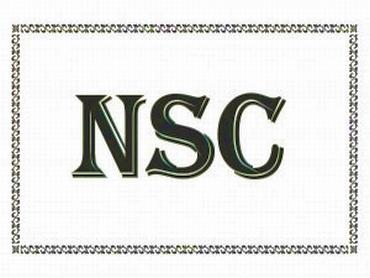 | « Back to article | Print this article |
Understanding the benefits of investing in National Savings Certificate
The reliable National Savings Certificate (NSC) looks like it may have lost popularity with countless competing investment options available such as equities, mutual funds, unit linked insurance and fixed maturity plans. However, there is no ignoring the instrument's respectable returns, which are not only assured, but also tax-exempt (under section 80C) and government-guaranteed.
Compared with the NSC, the Public Provident Fund (PPF) has traditionally been more popular on account of its 8 per cent tax free interest. However, the PPF has a maximum investment limit of Rs 70,000 per annum which means the maximum amount one can invest in PPF every year is capped at Rs 70,000).
Investment limit
NSCs do not have a limit of how much you can invest. What's more, interest earned on NSC investments up to Rs 1 lakh is tax free. You read that correctly. NSCs offer you the possibility of earning up to Rs 1 lakh without paying tax whatsoever.
This is because NSC is the only small saving scheme wherein not only the initial deposit, but also the interest for the first five years, out of its term of six years, is eligible for a deduction under section 80C.
Interest and returns
NSC offers 8 per cent interest compounded half-yearly. Due to this compounding, the effective interest rate per annum works out to 8.16 per cent. It is a cumulative scheme with a term of six years, meaning, though the interest accrues every year, it is paid to the investor together with the initial capital invested at the end of six years.
For example, Rs 10,000 invested in NSC today will grow to Rs 16,010 at the end of six years compounded annually at effective interest rate of 8.16 per cent.
Read NEXT to understand why NSCs are tax free.
Tax treatment
Let's talk about the tax treatment of the interest paid out. Unlike PPF, where the full amount of interest is tax free, NSC interest is taxable. However, as it is a cumulative scheme (for example, interest is not paid to the investor but instead accumulates in the account), each year's interest for the first 5 years is automatically re-invested in the NSC.
Since it is deemed re-invested, it qualifies for a fresh deduction under Sec 80C, thereby making it tax free.
Only the final year's interest, when the NSC matures, does not receive a tax deduction as it does not get reinvested, but is paid back to the investor along with the interest of the earlier years and the capital amount.
Illustration (All values indicating interest earned have been rounded off for simplicity:
Assume that you invested Rs 1,00,000 in an NSC on April 1, 2010. Interest on this investment for each year is shown in the following table:
April 1, 2010: Initial investment = Rs 1,00,000.
March 31, 2011: Interest for the first year = Rs 8,160
Explanation: Rs 1,00,000 multiplied by 8.16 and then divided by 100).
March 31, 2012: Interest for the second year = Rs 8,830
Explanation: For the second year your principal will be Rs 1,00,000 + Rs 8,160 = Rs 1,08,160. This is because the interest of Rs 8,160 earned in the first year is added to your initial investment of Rs 1,00,000 and then interest (at 8.16 per cent) earned is calculated on Rs 1,08,160.
March 31, 2013: Interest for the third year = Rs 9,550
Explanation: For the third year your principal will be Rs 1,08,160 + Rs 8,830 = Rs 1,16,990. This is because the interest of Rs 8,830 earned in the second year is added to your corpus of Rs 1,08,160 and then interest (at 8.16 per cent) earned is calculated on Rs 1,16,990.
March 31, 2014: Interest for the fourth year = Rs 10,330
Explanation: For the fourth year your principal will be Rs 1,16,990 + Rs 9,550 = Rs . This is because the interest of Rs 9,550 earned in the third year is added to your corpus of Rs 1,16,990 and then interest (at 8.16 per cent) earned is calculated on Rs 1,26,540.
March 31, 2015: Interest for the fifth year = Rs 11,170
Explanation: For the fifth year your principal will be Rs 1,26,540 + Rs 10,330 = Rs 1,36,870. This is because the interest of Rs 10,330 earned in the fourth year is added to your corpus of Rs 1,26,540 and then interest (at 8.16 per cent) earned is calculated on Rs 1,36,870.
March 31, 2016: Interest for teh sixth year = Rs 12,070
Explanation: For the sixth year your principal will be Rs 1,36,870 + Rs 11,170 = Rs 1,48,040. This is because the interest of Rs 11,170 earned in the fifth year is added to your corpus of Rs 1,36,870 and then interest (at 8.16 per cent) earned is calculated on Rs 1,48,040).
Total interest earned in six years = Rs 60,110 (Rs 8,160 + Rs 8,830 + Rs 9,550 + Rs 10,330 + Rs 11,170 + Rs 12,070)
Total value of investment at the end of sixth year which will be taxed = Rs 1,60,110 (Rs 1,00,000 + Rs 60,110.
What you must ensure while filing tax return
To benefit from this feature of re-invested interest and its deduction, it is important to declare the accrued interest on NSC on a yearly basis in your tax return.
In the above example, for financial year 2010-11 (the current financial year), you will include the interest amount of Rs 8,160 in your tax return under the head 'Income from other sources'. Under deductions, you will claim Rs 8,160 under Section 80C as re-invested NSC interest. Both cancel each other out, making the interest in effect tax free.
Read NEXT to read what you need to know while claiming tax deduction for your NSC investments
Important detail
From the above discussion, it is shown that both NSC and PPF interest is tax free. However, the difference is that PPF interest is tax free per se, whereas the NSC interest becomes tax free on account of the deemed reinvestment under Section 80C.
Remember that Section 80C has a maximum limit of Rs 1 lakh.
Your NSC interest would only qualify for the deduction provided you have funds left in Section 80C. Provident fund contributions, insurance premiums, housing loan principal repayments, tuition fees, PPF, tax saving mutual funds and bank deposits -- not to mention any fresh investment in NSC -- are also covered under the same Rs 1 lakh limit. So, if you want to invest and take advantage of the tax-saving feature of NSC interest, remember to make the adjustment so far as the other tax-saving investments are concerned.
Where and how to buy?
National Savings Certificates (NSC) are issued by Department of Post, Government of India, and are available at most post offices in the country in denominations of Rs 100, Rs 500, Rs 1,000, Rs 5,000 and Rs 10,000. NSCs can also be transferred from one person to another by paying a small fee. They can also be transferred from one post office to another.



